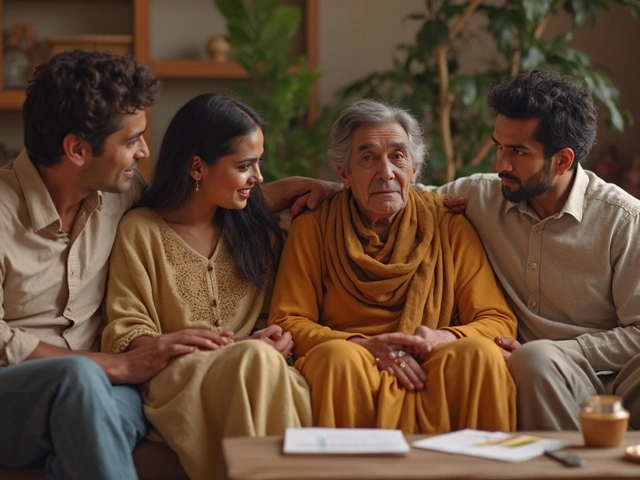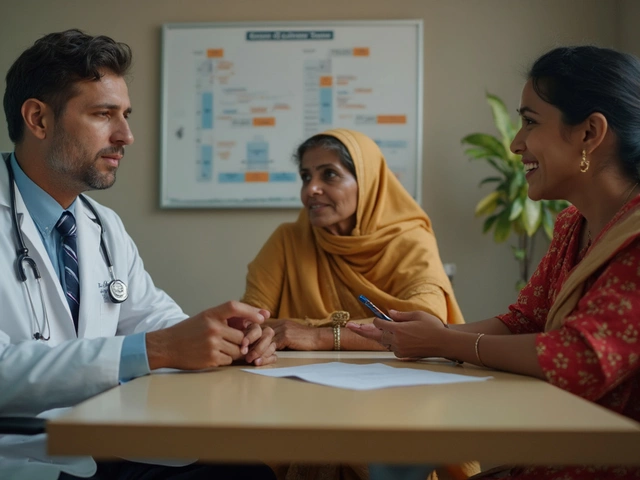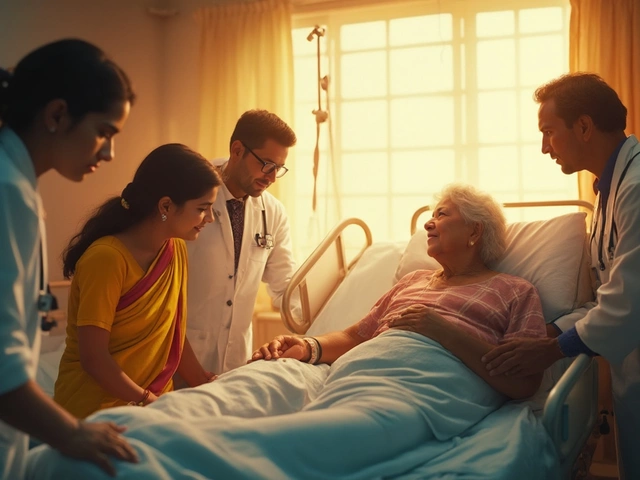
Easiest Cancer to Fight: Facts, Realities, and What Makes a Difference
If you ask doctors which cancer is easiest to fight, most will say there isn’t just one simple answer. But some cancers do have much higher survival rates, mostly because they're found early or grow slowly.
Let’s get real—nobody wants to talk about cancer, but knowing which ones carry better odds can make a huge difference if you or someone you love faces it. Some cancers, like certain types of skin cancer, can almost always be treated successfully when found early. Others, like testicular cancer, have survival rates over 95% if caught before they spread.
The key is understanding what makes these cancers 'easier': clear warning signs, easy access for a doctor to check, and effective treatments that work fast. Learning the basics can put you ahead, even if just a little. Want to know more? Let’s break down why these cancers usually come with a better outlook, what to look for, and how to boost your chances no matter what.
- Why Some Cancers Are Easier to Fight
- Skin Cancer: The Common Standout
- Testicular Cancer: Strong Odds for Men
- Thyroid Cancer: High Survival with Treatment
- Catching Cancer Early: The Real Game Changer
- Tips to Put the Odds in Your Favor
Why Some Cancers Are Easier to Fight
People often wonder why doctors say some cancers are just easier to deal with than others. A big part of it comes down to whether you can spot the cancer early and whether treatment is likely to work right away. Early warning signs and easy access for a doctor to check the suspicious area play a huge role.
Early detection is the biggest game-changer. For example, cancers like skin cancer or testicular cancer are usually easier to notice. You can see a mole change color, or feel a lump. Because you or your doctor can spot these things before they spread, it’s much easier to remove or treat them right away.
Another key factor is how fast the cancer grows. Some cancers, like certain types of thyroid cancer, typically move so slow you’ve got time to find them before they become a big problem. Others, like pancreatic cancer, often spread before you even know they’re there, making treatment much harder.
Here’s what typically makes a cancer easier to fight:
- Obvious symptoms early on (like a lump or a strange mole)
- Located somewhere a doctor can easily reach and test
- Slow-growing, so there’s more time to catch it
- Highly effective treatments available, sometimes even a simple surgery
- Well-researched, so doctors already know how to deal with it
Take a look at this quick comparison showing the average 5-year survival rates for some of the easiest cancers to fight versus the toughest:
| Cancer Type | Five-Year Survival Rate (%) |
|---|---|
| Skin (Basal Cell & Squamous Cell) | Over 95% |
| Testicular | Over 95% |
| Thyroid | 98% |
| Pancreatic | 12% |
| Lung | 27% |
So when someone talks about the "easiest cancer to fight," they're usually thinking about cancers with high survival rates, clear warning signs, and straightforward treatments. That’s what puts you or your doctor in a much better position right from the start.
Skin Cancer: The Common Standout
If you hear about the easiest cancer to treat, doctors will often bring up skin cancer. The truth is, most skin cancers—especially basal cell and squamous cell types—are found while they’re still small and just hanging out on your skin. That makes them way easier to deal with than cancers that hide deep inside the body.
Basal cell carcinoma is the most common form, and it rarely spreads. Treating it can be as simple as a quick procedure in a dermatologist’s office. Squamous cell is also pretty common, and if you catch it early, it’s usually knocked out with one treatment, maybe two if you want to be extra careful.
Early detection gives you a huge head start. Catch it before it spreads, and the five-year survival rate for basal cell and squamous cell skin cancer is above 95%. That’s not wishful thinking—it’s real data. The story is similar for the less common but more serious melanoma. If you find melanoma soon enough, chances of beating it are high too. If you wait too long, it gets dangerous quickly.
Here’s why skin cancer holds the top spot when people talk about easier cancer fights:
- Most cases found early, right on the skin
- Symptoms are visible
- Simple outpatient treatments available (freezing, cutting out, or topical meds)
- Recoveries are fast—sometimes as little as a few days off work
What makes it even better—the stuff you need to check for is simple. You don’t need special equipment. Just know your own skin:
- Notice a new growth or sore that doesn't heal?
- See a mole that’s changing, getting bigger, or looking weird?
- Any spot that bleeds easily?
If you see this stuff, don’t wait. Get it checked. Early action is the main reason skin cancer treatment works so well for most people.
| Type | % Found Early | 5-Year Survival Rate |
|---|---|---|
| Basal Cell | ~80% | >99% |
| Squamous Cell | ~70% | 95-99% |
| Melanoma (early) | ~70% | Over 90% |
Wrap all this up: if you have to pick a cancer to fight, skin cancer—as long as you catch it early—really is the more "beatable" one.
Testicular Cancer: Strong Odds for Men
This one stands out when you talk about the easiest cancer to fight—mainly because modern treatments work well and it's often caught before it spreads. Testicular cancer mostly hits younger guys (usually between ages 15 and 40), but that doesn’t make it scarier. Here’s what should actually get your attention: the survival rate is above 95% if it hasn’t spread outside the testicle.
A big reason for these strong odds? Regular self-checks. Any guy can do this in the shower—just roll each testicle gently between your fingers looking for a lump, swelling, or a weird heaviness. If you notice something off, don’t sit on it. See a doctor right away. Early detection is a huge deal here.
| Stage | Five-Year Survival Rate |
|---|---|
| Localized (in testicle) | 99% |
| Regional (nearby lymph nodes) | 96% |
| Distant (spread further) | 73% |
Even when testicular cancer spreads, treatments like surgery, chemotherapy, or radiation often work. Most guys will go back to regular life after treatment. Losing a testicle usually doesn’t affect sex or having kids since the other testicle steps up.
Here’s what you should remember:
- Don’t ignore lumps or changes—even if they don’t hurt.
- Self-check monthly, especially if you have a family history.
- Most lumps aren’t cancer, but it’s not worth guessing. Always get them checked.
Thanks to greater awareness and better treatments, testicular cancer has gone from scary news to one of the true cancer treatment success stories. Not every cancer gives you this kind of fighting chance, but for this one? The odds are definitely in your favor if you act early.

Thyroid Cancer: High Survival with Treatment
Here’s something a lot of people don’t realize: when it comes to the easiest cancer to fight, thyroid cancer often tops the list. Why? It’s usually found early, and most types grow slowly. In fact, the five-year survival rate can hit 98% for the most common types if you catch it before it spreads beyond the neck. That’s way better than for most others.
The thyroid sits right in front of your neck, which actually makes it easier for doctors to spot lumps or changes during a regular checkup. Most folks find thyroid cancer because they notice a painless lump or swelling or their doctor catches it during an exam or scan done for some other reason. That chance of running into it early is a big reason people beat it so often.
Here’s how the numbers break down for the main types of thyroid cancer:
| Type | Percent of Cases | Five-Year Survival Rate |
|---|---|---|
| Papillary | 80% | >98% |
| Follicular | 10% | 95% |
| Medullary | 4% | 75% |
| Anaplastic | 2% | <10% |
Treatment usually involves removing the thyroid (a surgery called thyroidectomy) and, sometimes, taking a few doses of radioactive iodine to zap any leftover cells. People live perfectly well just taking a daily thyroid hormone pill afterward. The process is surprisingly routine compared to some other cancer treatment plans out there.
To sum it up, if there’s a cancer you want on your side of the fence, thyroid cancer is one of the best bets in terms of cancer survival. Dr. Maria Enewold, a thyroid expert, puts it simply:
“With early detection and proper treatment, most patients with thyroid cancer can expect to live a normal, healthy life after recovery.”
So, the main takeaways? Know the symptoms—like a lump in your neck, hoarseness, or trouble swallowing. Get your doctor to check anything odd, especially if it sticks around. And if you do hear the word 'cancer' and it’s about your thyroid, understand the odds are stacked in your favor from the start.
Catching Cancer Early: The Real Game Changer
You keep hearing it: catch cancer early and your odds shoot up fast. That’s not just hype. In real life, early detection is the closest thing to a superpower when it comes to beating the disease. For many of the easiest cancers to fight, survival rates can jump from scary to almost routine just by finding them soon enough.
Here’s a solid fact: melanoma, a serious skin cancer, has a five-year survival rate of about 99% if it’s caught before it spreads. But let it get deep or reach the lymph nodes? That number drops majorly. It’s a similar story with testicular cancer and certain types of thyroid cancer: the earlier you spot the trouble, the simpler the journey usually is.
Dr. Lisa Richardson from the CDC says it straight up:
"Early detection gives people the best shot at beating cancer. That means more lives saved and easier treatments."
Most cancers send out some warning signs, but not all of them are obvious. That’s why regular screening and knowing what’s normal for your body matters more than most people think. Here are a few things that help tip the balance in your favor:
- Go for regular skin checks, especially if you’ve got a lot of moles or freckles.
- If you’re a guy, check for lumps or changes in your testicles every month. Super simple, takes a minute.
- Talk to your doctor about family history—some people need screening younger or more often than average.
- Don’t ignore stuff that feels new or weird, like sudden lumps, weird bleeding, or a change in your skin.
Take a look at how survival stats jump if cancer is caught early (easiest cancer types):
| Cancer Type | Survival Rate - Early | Survival Rate - Late |
|---|---|---|
| Melanoma (Skin) | 99% | 32% |
| Testicular | 95% | 73% |
| Thyroid | 98% | 53% |
So, yeah, catching cancer early isn’t just about peace of mind. It straight up changes the game. No one wants an extra doctor visit, but a quick check can mean treatment is way easier and your life barely misses a beat.
Tips to Put the Odds in Your Favor
If you really want to stack the deck against cancer, it’s not just about luck or genetics—daily choices play a big part. There’s actually solid data behind the changes that make a difference in cancer survival and recovery. Here’s a practical game plan:
- Don’t skip check-ups. Annual skin screenings or basic blood work might sound boring, but early detection is the number one factor in easier cancer treatment. For example, skin, testicular, and thyroid cancers are a lot easier to treat when caught early.
- Know your own risk. Family history matters. If your uncle or mom had thyroid or testicular cancer, tell your doctor. They can help you get the right tests sooner or more often. Some tests (like thyroid ultrasounds) are painless and take just a few minutes.
- Look for changes. Weird moles, lumps, or swelling—don’t ignore them. If a mole changes shape or color, or you find a lump, get it checked. The earlier it’s looked at, the higher the odds for an easy fix.
- Don’t smoke, and keep the sunscreen handy. Not all cancers are linked to smoking or sun, but these two habits are huge risks for a bunch of cancers that otherwise have high treatment success (like skin cancer).
- Healthy living still works. Eating more veggies, moving a little every day, and keeping alcohol low really do make a difference. They slash the odds of a handful of cancers and help you recover faster if you ever do get sick.
| Tip | Impact |
|---|---|
| Annual skin check | Early skin cancer detection, 99% survival rate if caught early |
| Quit smoking | Cuts overall cancer risk by over 30% |
| Physical activity | Lowers chances of several cancers and boosts recovery |
If you do end up fighting cancer, find a doctor or clinic you like and trust. Ask questions. Bring someone with you if you’re nervous about forgetting stuff. Smart choices, small habits, and a bit of backup can really tip the scales in your favor.

Arnav Singh
I am a health expert with a focus on medicine-related topics in India. My work involves researching and writing articles that aim to inform and educate readers about health and wellness practices. I enjoy exploring the intersections of traditional and modern medicine and how they impact healthcare in the Indian context. Writing for various health magazines and platforms allows me to share my insights with a wider audience.
About
Medical Resource Center India is a comprehensive online platform dedicated to providing reliable health information and medical resources in India. Explore a wide range of articles, tips, and advice on medicine, healthcare services, and wellness. Stay informed about the latest developments in Indian medicine and access valuable insights into maintaining a healthy lifestyle. Discover expert guidance and health solutions tailored for every Indian citizen. Your go-to destination for authoritative medical knowledge in India.








